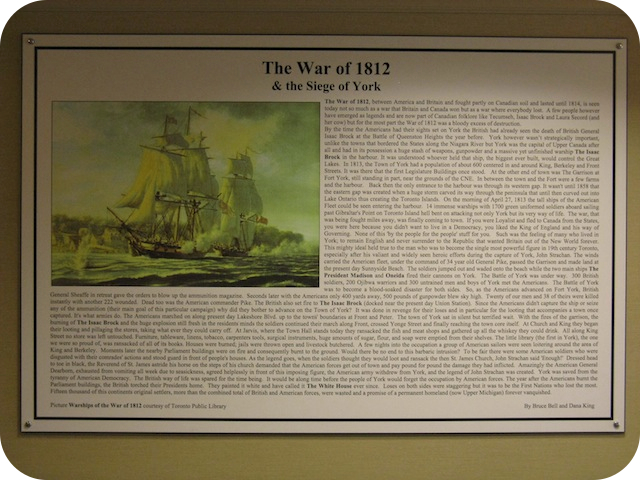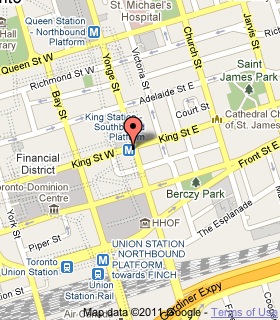Discover Toronto's history as told through its plaques
2004 - Now in our 14th Year - 2018
To see what's new on this site, you can visit the Home Page
Looking at this page on a smartphone?
For best viewing, hold your phone in Landscape mode (Horizontal)
The War of 1812 & the Siege of York

Photos and transcription by contributor Wayne Adam - Posted April, 2010

At 1 King Street West (the white tower on the left), at the elevator lobby on the 30th floor, is this Bruce Bell and Dana King plaque. Here's what it says:
Coordinates: 43.648780 -79.378254 |
 |
The War of 1812 between the United States and Britain, fought partly on Canadian soil and lasting until 1814, is seen today not so much as a war that Britain and Canada won, but as a war where everybody lost. A few people, however, have emerged as legends and are now part of Canadian folklore, like Tecumseh, Isaac Brock, and Laura Secord (and her cow). But for the most part, the War of 1812 was a bloody excess of destruction. By the time the United States had its sights set on York, the British had already seen the death of General Isaac Brock at the Battle of Queenston Heights the year before. York, however, wasn't strategically important, unlike the towns that bordered the States along the Niagara River. But York was the capital of Upper Canada, after all, and had in its possession a huge stash of weapons, gunpowder, and a massive yet unfinished warship, The Isaac Brock, in the harbour. It was understood whoever held that ship, the biggest ever built, would control the Great Lakes.
In 1813, the Town of York had a population of about 600 centered in and around King, Berkeley and Front Streets. It was there that the first Legislative Buildings once stood. At the other end of town was the Garrison at Fort York, still standing, in part, near the grounds of the CNE. In between the town and the Fort were a few farms and the harbour. Back then, the only entrance to the harbour was through its western gap. It wasn't until 1858 that the eastern gap was created when a huge storm carved its way through the peninsula that, until then, curved out into Lake Ontario, thus creating the Toronto Islands.
On the morning of April 27, 1813, the tall ships of the U.S. Fleet could be seen entering the harbour: fourteen immense warships with 1700 green uniformed soldiers aboard, sailing past Gibraltar's Point on Toronto Island, hell-bent on attacking not only York, but its very way of life. The war that was being fought miles away was finally coming to town. If you were Loyalist and fled to Canada from the United States, you were here because you didn't want to live in a Democracy, you liked the King of England and his way of governing. None of this 'by the people, for the people' stuff for you. Such was the feeling of many who lived in York: to remain English and never surrender to the Republic that wanted Britain out of the New World forever. This mighty ideal held true to the man who was to become the single most powerful figure in 19th century Toronto, especially after his valiant and widely seen heroic efforts during the capture of York, John Strachan. The winds carried the American fleet, under the command of 34-year-old General Pike, past the Garrison, and made land at the present-day Sunnyside Beach. The soldiers jumped out and waded onto the beach while the two main ships, The President Madison and Oneida, fired their cannons on York. The Battle of York was underway.
Three hundred British soldiers, 200 Ojibwa warriors and 300 untrained men and boys of York met the Americans. The Battle of York was to become a blood-soaked disaster for both sides. So, as the Americans advanced on Fort York, British General Sheaffe, in retreat, gave the orders to blow up the ammunition magazine. Seconds later, with the Americans only 366 m away, 227 kg of gunpowder blew sky high. Twenty of our men and 38 of theirs were killed instantly, with another 222 wounded. Dead too was the U.S. commander, Pike. The British also set fire to The Isaac Brock (docked near the present-day Union Station). Since the U.S. didn't capture the ship or seize any of the ammunition (their main goal of this particular campaign) why did they bother to advance on the town of York? It was done in revenge for their losses, and in particular, for the looting that accompanies a town once captured. It's what armies do. The U.S. marched on along present-day Lake Shore Blvd., up to the town's boundary at Front and Peter.
The town of York sat in silent but terrified wait. With the fires of the garrison, the burning of The Isaac Brock and the huge explosion still fresh in the residents' minds, the soldiers continued their march along Front, crossed Yonge Street and finally reached the town core itself. At Church and King, they began their looting and pillaging the stores, taking whatever they could carry off. At Jarvis, where the Town Hall stands today, they ransacked the fish and meat shops and gathered up all the whiskey they could drink. All along King Street, no store was left untouched. Furniture, tableware, linens, tobacco, carpenters' tools, surgical instruments, huge amounts of sugar, flour, and soap were emptied from their shelves. The little library (the first in York), the one we were so proud of, was ransacked of all of its books. Houses were burned; jails were thrown open and livestock butchered. A few nights into the occupation, a group of U.S. sailors were seen loitering around the area of King and Berkeley. Moments later the nearby Parliament buildings were on fire and consequently burnt to the ground. Would there be no end to this barbaric intrusion?
To be fair, there were some U.S. soldiers who were disgusted with their comrades' actions and stood guard in front of people's houses. As the legend goes, when the soldiers thought they would loot and ransack the then St. James Church, John Strachan said 'Enough!' Dressed head to toe in black, the Reverend of St. James, astride his horse on the steps of his church, demanded that the U.S. forces get out of town and pay, pound for pound, the damage they had inflicted. Amazingly, the U.S. General Dearborn, exhausted from vomiting all week due to seasickness, agreed, helplessly, in front of this imposing figure. The U.S. army withdrew from York, and the legend of John Strachan was created. York was saved from the tyranny of American Democracy. The British way of life was spared for the time being. It would be a long time before the people of York would forget the occupation by U.S. forces. The year after the U.S. burned the Parliament buildings, the British torched their President's home. They painted it white and have called the White House ever since. Losses on both sides were staggering, but it was to be the First Nations who lost the most. Fifteen thousand of this continent's original settlers, more than the combined total of British and U.S. forces, were wasted, and a promise of a permanent homeland (now Upper Michigan) forever vanquished.
Related webpages
The War of 1812
York
Upper Canada
Isaac Brock
General Pike
Ojibwa
General Dearborn
White House
Related Toronto plaques
The Battle of York 1813
The Bishop's Palace 1818
Canadian National Exhibition
Colonel W.J. Stewart
The Defence of York
Ontario's First Parliament Buildings 1798
Fort York
Fort York
Gibraltar Point
Landing of American Troops at York
Military Burial Ground
The Old Garrison Burying Ground 1794-1863
The Second Invasion of York
St. James' Cathedral
St. Lawrence Hall 1850
Toronto Island
Victoria Memorial Square
Yonge Street 1796
More Bruce Bell History Project plaques
132 Front Street East
The Colborne Street Theatre
First Theatrical Performance
The Great Fire of 1849
Keating Coffee House
Rebellion of 1837
Samuel Lount and Peter Matthews
West Market Street
York's First Jail
Related Ontario plaques
The War of 1812
Tecumseh 1768-1813
Battle of Queenston Heights
Laura Ingersoll Secord 1775-1868
Major-General Sir Isaac Brock
Sir Roger Hale Sheaffe 1763-1851
United Empire Loyalists
Right Reverend John Strachan 1778-1867
More
Conflict
Here are the visitors' comments for this page.
> Posted July 31, 2012
Wonderful presentation of information; a valuable resource for the public. Keep up the good work.
Grant Hilliard
Here's where you can send me a comment for this page.
Note: Your email address will be posted at the end of your comment so others can respond to you unless you request otherwise.
Note: Comments are moderated. Yours will appear on this page within 24 hours (usually much sooner).
Note: As soon as I have posted your comment, a reply to your email will be sent informing you.
To send me your comment, click [email protected].
Thanks
Webmaster
Note: If you wish to send me a personal email, click here.